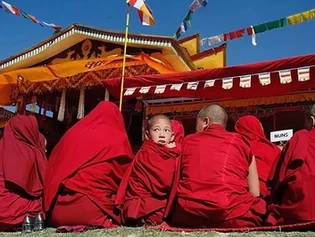Tibetan Buddhist Temple
Dress Modestly
Either male or female should have both the legs and the shoulders covered.
Take off your shoes. (When visiting a temple, make sure you take off your footwear at the entrance).
Do not take pictures with your back facing Buddha statues. Taking photographs is acceptable in most Buddhist temples but make sure that whatever pictures you take do not face your back towards the Buddha statues or images.
You can meditate or just sit silently next to walls, but not in the center.
You can visit the Puja ceremony in the early morning to have an amazing experience of morning prayers, music instruments, and chanting. Usually, it starts around 6:30 am. A puja is a special ceremony in which prayers are offered to the Buddhas to request their blessings or invoke their help.
Praying wheels
A mantra is a word, a syllable, a phrase or a short prayer that is spoken once or repeated over and over again (either aloud or in a person’s head) and that is thought to have a profound spiritual effect on the person.
Mantras may also be displayed on a prayer wheel and repeated by spinning the wheel, or written on a prayer flag – in which case the prayer is repeated each time the flag moves in the wind. You can spin the praying wheel inside or outside a temple.
Taking pictures of monks or nuns.
You can take a picture of a monk, but not secretly. Ask first. Usually, they are happy to take a picture with you, but sometimes they can refuse. You should respect their decision.
Talking to Tibetan monks or nuns.
You can approach a monk/nun if you see they are not busy. Politely ask your question, show respect.
Buddhist temples in Zen/Chan Buddhism
Buddhist temples in Zen/Chan Buddhism used to be the center of culture; they were not only used as places of worship, but also as schools, hospitals, dispensaries, orphanages, and homes for older people. The monks were also school teachers, physicians, engineers, and developers of many construction projects. Even now you can see that a lot of Zen/Chan Monasteries are not just a temple. A great example is Fo Guang Shan and Dharma Drum Mountains in Taiwan.
Visiting a Zen Monastery
Behave calmly and respectfully.
The entrance of Zen Temple often has a place for you to remove your shoes. This isn’t optional. Some temples provide storage shelves for shoes, other temples provide a plastic bag.
You are not supposed to visit a shrine if you are sick, have an open wound or are mourning because these are considered causes of impurity.
Please wear loose-fitting clothing, dark or muted in color so as not to distract others.
Please dress modestly and do not wear shorts, sleeveless shirts, short skirts, tank tops or any perfumes or fragrances.
Burning intense.
At some temples, visitors burn incense in large incense burners. Purchase a bundle, light them, let them burn for a few seconds and then extinguish the flame by waving your hand rather than by blowing it out. Finally, put the incense into the incense burner and fan some smoke towards yourself as the smoke is believed to have healing power.
Photography is usually permitted on the temple grounds, but is often forbidden inside the buildings. Watch for signs.
You can meditate inside the temple. Find a place, sit quietly, close your eyes and meditate.
Donate: Most temples open to the public are free of charge, thus donating is a good way to help keep these public places of worship open.
If you still have any questions, please do not hesitate to ask!



